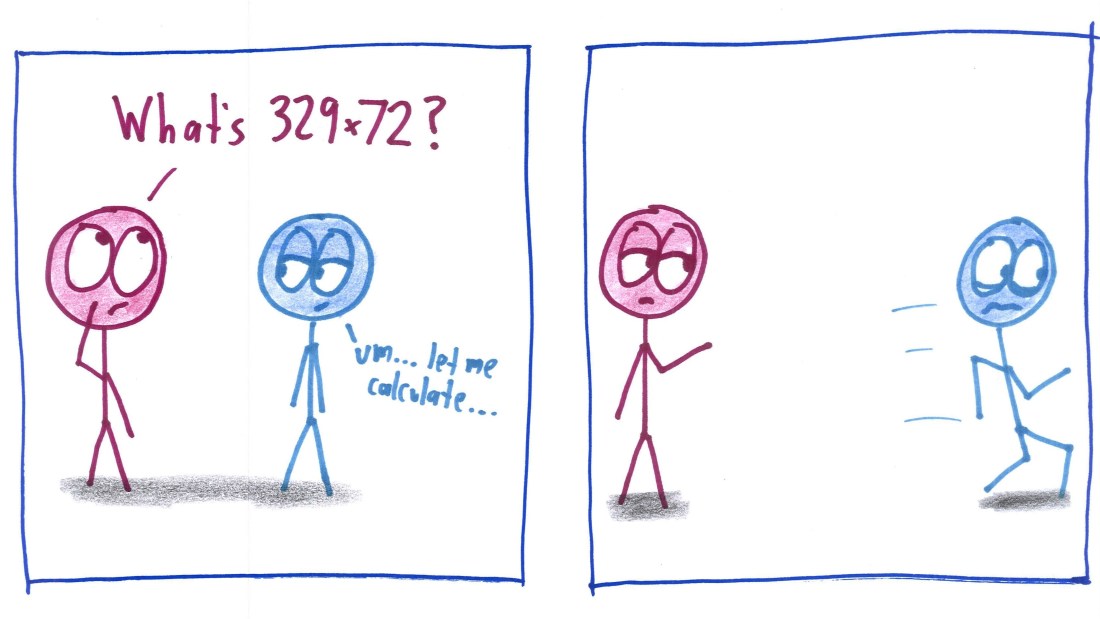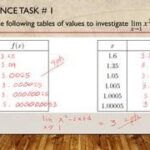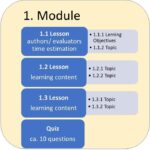NOTE: I wrote this essay in 2015, shortly after the events described. As with any sensitive document, I chose to wait several years to publish it, so as to protect the careers, reputations, and fragile egos of those involved (most of all my own). Please read it with the leering disrespect it deserves.

I discovered recently that I can’t multiply 2573 by 389.
Neither can you, I bet.
Really, go ahead. Try it. Grab a pencil and paper. Use the standard algorithm. Give it the level of focus you’d normally give such an operation (so if you wouldn’t usually quadruple-check your work, don’t do it now, you little cheater. We want a fair test). Then, when you’re done, check your answer (you can just type it into Google).
How did it go?
The background: I’m lucky enough to work in a sterling mathematics department. Our school routinely sends mathematicians to Oxford and Cambridge. We’ve got six kids taking the highest level of IB Mathematics; there are only 300 students doing that in the world. It is, in short, a really impressive department.
So the teachers ought to be able to multiply integers, right?
I tried the problem myself, and failed. An addition mistake was my kryptonite. The department was 0 for 1.
I threw the problem to one colleague, who lofted a skeptical eyebrow at my ineptitude, then tried and stumbled himself. 0 for 2.
Another colleague showed up. When he too made a mistake in his computation, he didn’t believe it, suggesting that perhaps I’d entered it into the calculator wrong. I laughed and compared him to a politician demanding a recount after a ten-point defeat.
0 for 3.
A third colleague, a brilliant scholar upon whom I lean for advice and wisdom, couldn’t do it either, and wondered if we were playing some trick, such as switching to a base other than 10.
The department was 0 for 4.
We gathered to lick our wounds. The problem, we agreed, was that there are just too many chances to slip up, too many ways to err. You’ve got to perform 12 multiplications and 15 additions, and you need to carry out most of the multiplication steps while holding a number from the last multiplication step in your memory.
That’s hard! It feels less like an efficient problem-solving method than like a task cooked up in a psychology lab to stretch the limits of short-term memory.
Or maybe this is all just sour grapes.
I told another colleague of our struggles. He shook his head. “Pitiful,” he teased.
“C’mon,” I said. “There’s obviously some number of digits that’s so large, everyone will make a mistake. No one will be able to correctly carry out, say, a 15-digit number times a 14-digit number.”
“Of course I can,” he said.
So I grabbed a piece of paper and set him a problem: 15-digits by 14-digits.
Thirty seconds in, he knew he’d bitten off more than he could chew. (To be fair, I was trash-talking loudly in his ear, to his justified annoyance.) Dutifully, though, he carried it out, eventually arriving at an answer.
A spectacularly wrong answer.
I suspect that if I’d given him the original problem at the start, he’d have managed it correctly. But now his swagger was shaken. He tripped all over himself, and erred on the 4-digit by 3-digit as well.
We were 0 for 5.
And you want to know the most damning fact, the one that had prompted me to launch this crazy multiplication witch-hunt in the first place? I’d drawn this question, this exact question, from a school test we’d given the previous November.
To 11-year-olds.
We expected our youngest students to do what we, apparently, could not.
With the dust settling, and our egos lying in rubble, I looked for takeaways. What does it mean that this question looks like a matter of brainless automaticity, and yet smart people with fancy math degrees can’t answer it?
At the extreme, you can conclude that teaching standard algorithms is pointless. After all, we’ve all got calculator apps in our pockets, and evidently, even the professionals can’t get the standard algorithms to produce a correct answer. Perhaps they’re no longer worth teaching.
Or you can run to the opposite extreme: the standard algorithms must be taught, and taught carefully. As our embarrassment shows, this computational stuff takes more effort and focus than you might expect. In our drive for conceptual depth, we mustn’t take computational fluency for granted.
To me, though, this isn’t a pro- or anti-algorithm parable. Instead, the whole episode is a master-level seminar in something simpler:
We need to walk in our students’ shoes.
It’s no big deal that we erred on the problem, and it’s forgivable that we underestimated its difficulty. (You probably did, too, before reading this post.) But these reasonable, well-meaning mistakes added up to something rather awful: us forcing our students to do something unnecessarily difficult and unenlightening, for no particular reason.
A class is like a mountain path. We set the trail that our students must hike. We choose the direction; we draw the map; and we leave the markers along the way so that they don’t get lost. Where they’ll face gaps, we build bridges. Where they’ll struggle to climb, we build stairs. Where they may stray, we build railings (or nets to catch them).
We don’t have time to double-check every inch of terrain. But if we lead them up a steep, hard hill, then we’d better ensure that it’s worth the struggle. It’s easy to send kids down a fruitless path, especially when you’ve had years to forget the rocks and obstacles.
It’s easy to ask a question that looks simple, and that you can’t actually do yourself.
So that’s my takeaway, a simple reminder that a teacher is a trail guide. He needs to test the path periodically, even if—no, especially if—he’s such an expert now that he can no longer remember what it’s like to walk the road for the first time.
But I’m sure you’re still wondering: Did anyone carry out the multiplication successfully? Yes, indeed, one person: a trainee Latin teacher named Emily who last took math when she was 15.






![Erratum for “An inverse theorem for the Gowers U^s+1[N]-norm”](https://azmath.info/wp-content/uploads/2024/07/2211-erratum-for-an-inverse-theorem-for-the-gowers-us1n-norm-150x150.jpg)

